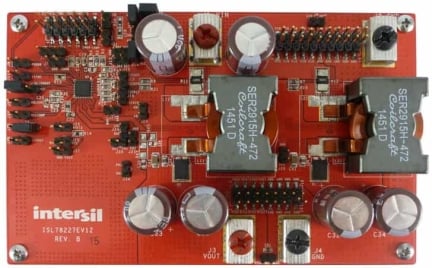概要
説明
The ISL78227 is an automotive grade (AEC-Q100 Grade 1), 2-phase, 55V synchronous boost controller that simplifies the design of high power boost applications. This device enables simple, modular design for systems requiring power and thermal scalability, and offer highly robust solutions for the most demanding environments.
The ISL78227EV1Z board demonstrates the 2-phase synchronous boost operation of the ISL78227. It verifies the high efficiency of synchronous boost operation and all the features of the IC including input constant current (CC) control, analog/digital tracking, diode emulation, phase dropping, etc.
特長
- Input/Output voltage withstands 55V DC and 60V transients
- Input average constant current (CC) control loop
- PWM and analog track functions
- Forced PWM operation with negative current limiting
- External synchronization
- Selectable continuous conduction mode (CCM), diode emulation (DE) and phase dropping (PH_DROP) modes
- Comprehensive protections
- Selectable hiccup or latch-off fault responses
- Boards can be stacked for parallel operations
- Monitoring test points for key signals
アプリケーション
- Automotive power systems (e.g., 12V to 24V, 12V to 48V, etc.)Trunk audio amplifier
- Start-stop system
- Automotive boost applications
- Industrial and telecommunication power supplies
設計・開発
ソフトウェア/ツール
製品選択
適用されたフィルター
ビデオ&トレーニング
Renesas introduces the ISL78227 and ISL78229 automotive-grade 55V, 2-phase synchronous boost controllers. The ISL78229 features a PMBus interface for advanced control, telemetry, and diagnostics. Renesas showcases how these devices address common challenges in automotive power design.
Transcript
ISL78227/29 55V Automotive Boost Controller
Hi, I'm Steve Schulte, Application Engineering Manager for automotive power management products at Intersil. Today I'd like to introduce Intersil's new automotive grade boost controllers, ISL78227 and ISL78229. The ISL78229 offers a PMBus interface for advanced control, telemetry and diagnostics.
I'm going to demonstrate how these devices provide several means to solve a common challenge in automotive power supply design. Often a system needs to dynamically adjust, scale, or modulate the power supply voltage based on load demands or system needs. For example, whenever the battery supply is low, power consumption of various components, such as audio amplifiers, must be limited, especially when the engine is restarted in start/stop operation.
The ISL78227 and ISL78229 offer a unique envelope tracking feature that dynamically adjusts or scales the output voltage on the fly to meet all system load demands.
Let me show you how this works on this ISL78229 evaluation board. Here I've set up the ISL78229, with an input supply of 12V and configured the output voltage to 36V. In this configuration it is set up to deliver a 3A current to the load. In addition, I have provided an analog envelope signal to the track pin via a function generator. The tracking bandwidth of the track pin is approximately 400Hz. Here I am providing a sinusoidal envelope at 200Hz. On the oscilloscope you can see the track signal on channel 1 in yellow and the corresponding output voltage on channel 4 in green. As you can see, the output voltage is proportional to the track input and is varying between 16V and 36V.
For systems that find it more convenient to create a digital PWM signal, such as a DSP or microcontroller based system, the track pin can also follow such a signal. Here I have provided a PWM signal, whose duty cycle varies in a triangular pattern. Now I'm going to switch to the output, which is varying between 16V and 36V, in the shape defined by the duty cycle of the PWM input.
In summary, the ISL78227 and ISL78229 are easy to use and also the industry's most robust and highly integrated boost controllers. Some of the key features include: two layers of overcurrent protection prevent runaway system damage, negative current protection prevents large currents that can damage the high-side FET, average current limiting allows high current for brief heavy load periods and prevents long durations that can cause overheating, diagnostic features to aid in ASIL compliance.
We have a complete set of support tools, such as evaluation boards, user guides and a white paper.


